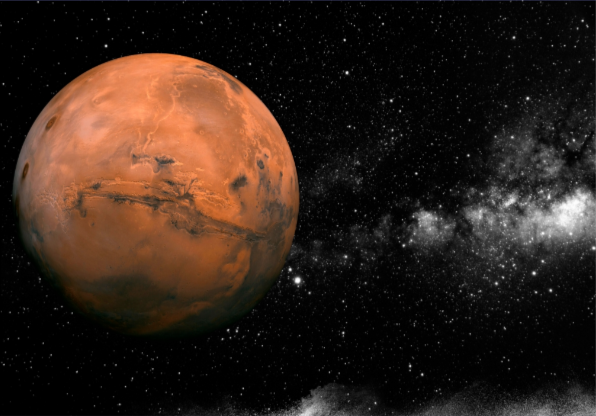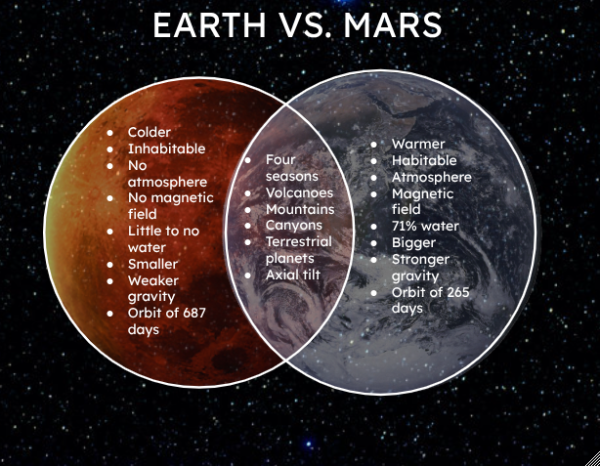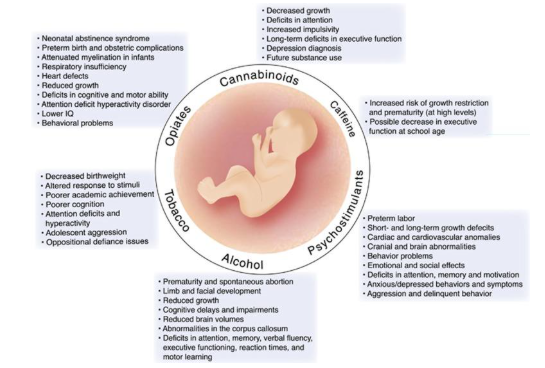When you think about the future, how do you imagine it?
Some people imagine flying cars, outstanding technology, and solving the World’s greatest problems. Others imagine a more Doomsday scenario, with complete global chaos. With these two ideas, terraforming can make or break these theorized ideas of either World peace or horrifying destruction.
Terraforming is the idea of manipulating a planet’s natural environment fit for life, or specifically humans. Usually when talking about terraforming, Mars is seen as the best candidate.
People who have opinions on this topic, genuinely see it in black or white. There is not essentially a grey area. As it is a topic which goes in depth on what we believe as a person, and what we believe is the best option for the future of humanity.
For the pros, people believe having a “backup planet” can promote reusability. It decreases the chance of human/life extinction, and an extra planet would serve to be quite the resource.
As for cons, some parts of society worry about the risks that come with the idea of colonizing another planet. Some of these being the possibility of destroying ecosystems, unforeseen environmental risks, and the amounts of energy and resources that would have to be used for it.
To know if terraforming Mars would be a good idea or not, we would have to know if Mars is suitable for human life, why we would ever need to migrate to another planet, and what we would need to terraform another planet.
Within the terraforming debate, one of the first topics brought up is if Mars would ever be able to be suitable for human life.
Many people think it would be nearly impossible for Mars to ever support life, at all. The planet Mars, unlike Earth, has a very thin atmosphere.
Within the atmosphere of the red planet, it is made up of 95% carbon dioxide, 3% nitrogen, 1.6% argon, and a small amount of oxygen in the mix. In order to make the air breathable for life, there would need to be a usage of highly advanced technology in order to do so.
Another problem is the red planet lacks a magnetic field, which means we would not be protected from deadly winds of the thin atmosphere.
“Creating a (1) magnetic field on the scale necessary to protect life, and (2) suitable atmosphere, and preventing it from escaping into space, are both beyond our technological abilities,” said Physics teacher, David Knorr.
With air which is highly poisonous to humans, and an atmosphere that is estimated to be 100 times less dense. Making an entire atmosphere an magnetic field for a planet can take a very long time, and would be highly experimental.
Which, makes it quite unlikely we will be living on Mars anytime soon. A different debated topic in terraforming is if destroying a different planet’s chance of its own, unique life, was morally wrong.
Some people believe warping the red planet’s natural environment would do no wrong, considering there are no traces or signs of independent life discovered on planet Mars for what we know today.
However, others think about the more hypothetical scenarios on what would happen if we artificially changed an environment.
“What if Earth were terraformed when life was in its earliest stage of evolution? Then human beings would not exist today. Why should we be allowed to decide the evolutionary fate of another world?” Knorr said.
With questions like these, we wonder if we, as a species, have the right to ruin the chances of another World’s unique life. If it ever has the right conditions for life.

In the controversial topics of terraforming, it is often asked why we would ever need to leave Earth in the first place.
We would most likely not need to leave planet Earth due to lack of materials, or some sort of Doomsday crisis. Most people who argue about this topic worry over the things that are out of our control, such as the possibility of asteroids hitting the surface.
Or, the eventual end of the sun, which is estimated to implode in 4.5 billion years.
When these things happen, if humans miraculously make it through such a long point of time, many people believe there is not another option but to leave our planet and look for refuge to another one.
“Humanity will at some point need to branch out into the universe, the Sun will only last for another 4.5 billion years. Also, humans are explorers by nature, and we see this pattern throughout our history,” Astronomy teacher Scott Raypole said.
With life on Earth having a deadline, space companies such as NASA are quickly searching for ways to have a “backup planet”, if something ever threatens human life.
Other than the problems we are not able to fix, what about the problems we can? Such as climate change, and the vast extinction of resources and organisms.
Many people believe the damage we have done to the Earth is irreversible, and can only keep decreasing until our planet is unusable. Others think we are not at a point of no return, and we are still able to preserve our planet and its resources.
“I believe we will figure out our environmental problems even if we need to go through a period of time with major species threatening problems. Humanity figured out and fixed the ozone hole, we will get pushed, but I believe will figure it out,” Raypole said.
At this point, climate change and deforestation is at an all time high. If we would like our planet to keep thriving and not have to consider a backup planet, then we must make a drastic change to how we use our planets’ resources.
So if we ever do decide to terraform, what would we need to do so?
As usually guessed, the cost of terraforming is quite the pretty penny. We would need a big sum of money to put research into it, and lots of Earth’s resources into making an atmosphere, food, and life appear on Mars.
This would include a lot of Earth’s vegetation, and limited resources to be able to bring life to Mars. This is what usually makes or breaks people’s decision about terraforming.
Yes, we would have another planet to thrive off of, but it could also damage our home planet immensely.
“I don’t think it is a bad idea, but I think it would take a lot of resources, money and time, possibly even human lives to accomplish a successful mission to make a non-Earthlike environment habitable for humans.” Biology teacher, Michelle Brenner said.
NASA believes they will be able to send people to Mars by 2030, but as said, things can go wrong easily in space.
Many people believe terraforming another planet is too dangerous, for humans and for Mars’ environment. Such as attempting to change the natural habitat of Mars could actually destroy the planet’s environment and chance of ever being able to support life, which many people find morally wrong to do.
However, others think Mars will never be able to support life on the planet by itself.
“Essentially nothing so far is living nor sentient there for what we know about Mars’s past. If there were actual martian animals there, it would be a more interesting argument,” Space and environment teacher Lionel Zhao said.
What we would also need to successfully terraform Mars is much more advanced technology than we have at this moment.
“The technology we have today would be nowhere close to what we need to terraform. I won’t underestimate the human race, but I think it will be well after any of us here now are alive,” Zhao said.
It could take decades, or centuries for us to ever be able to even terraform another planet successfully.
 However, as technology rapidly becomes more advanced, we still question whether colonizing planets is in the future.
However, as technology rapidly becomes more advanced, we still question whether colonizing planets is in the future.
The controversial debate about if Mars should be terraformed is about if Mars could support life, would it give us more pros, or more cons? For what we know now, Mars has the possibility of being able to support life from Earth.
Mars could serve as a “backup planet” if anything ever happens to our home planet, but is in need of big amounts of Earth’s resources. It is what we think as a society morally, ethically, and logically gives us pause on if it is or is not a good idea.
Despite the topic being one which is not estimated to be acted upon for decades, or perhaps centuries,we question if it should be an achievement of the future. Will we ever act upon the foreign adventures, or will we fix the World we currently live in?
What we need to focus on is what is best for the World that we live in, and if terraforming another planet to live on is worth it. “Humanity will always adapt to its environment. Even if it’s a painful transition,” Raypole said.








